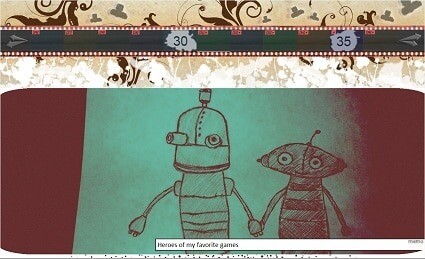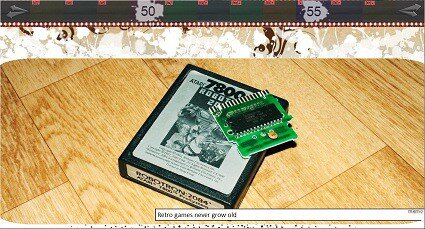Developer Summary
This game is about a person who kept running through his life, never looking back at the past. He rarely slept, and even with 24 hours in a day, it was not enough for him.
Once during a trip, he gets into trouble. Now he’s lying on the cold ground, buried beneath his bicycle.
Slides of various moments fly through his head. Will his memories return? Will he be able to stand up again?
You must help him. You have about 630 beats of the heart to restore his past.
What We Think
Retention is a stylish staging of hundreds of photos, turning the collection into a character building exercise somewhere between “Memento” and “Choose Your Own Adventure” titles. Can a man be truly defined by frozen moments of his history? Is identity really just a question of perspective?

Like riding a bike
The player regains consciousness only to discover that he’s been in some sort of a bike accident and is unable to get up. Trios of memories come flooding back to him as he tries to piece together his back story. If he can’t assemble his “correct” memories before time runs out, his personality will be lost forever.
Don’t take my kodachrome away
The images used in the game are all the work of Evgeniy Kolpakov and his girlfriend, Alina Ovchinnikova. All of the photos were taken over the span of the last ten years. Shutterbugs and enthusiasts alike will enjoy the various different techniques employed in the wide array of shots.
There are 85 frames in total. Each presents three photos (of which, the player must choose one) and each will have to be referenced to complete the profile. Some photos will be of touching family moments, memories of times out with friends, or beautiful shots of landscapes. Other images may not be from the player’s memories at all. The memories of the player will ultimately be shaped by any trends that emerge from the photos that are selected.
Did the player surround himself with friends and loved ones, or did he spend his days absorbed in thoughts of the future? Was the injury serious enough that the player can’t be certain if the memories are even his? Hovering over a selection within a trio will colorize the image, and provide the only clues that can be obtained without actually selecting the photo. Clicking on one photo in the trio will designate that photo as the guiding force behind that frame, and provide a brief interpretation of the choice. Once a photo is selected, it represents that slide, and can’t be unselected. Multiple play-throughs will be required to experience other character outcomes, though each new game will wipe the previous slate clean.

Sounds of Silence
The music that accompanies the spiritual journey is sometimes racy, other times guttural and ambient, feeling like it is lurking just off-frame for the duration of the game. Try to envision an accomplished, yet fallen blues artist pouring out his soul at a church organ all the while trapped in a dusty vacuum canister. After a couple of rounds, it will become clear how much time is left based solely on which song plays, adding a much needed sense of urgency.
Unfortunately, that won’t be revealed until the player first fails to assemble the memories in the allotted time; there is no clock, or clues for a countdown other than the aforementioned 630 heartbeats (which are somewhat audible as percussion in the music, though there is no cumulative count displayed), so the first “Game Over” screen – a frame telling the player that he has failed to assemble his memories in time – is that all that indicates that there is any reason to be concerned. A typical game can last up to a maximum of ten and a half minutes, so having to start from scratch on a game with no variation can be a bit discouraging.
It also isn’t immediately clear that all frames must be viewed and selected to “complete” the player’s memory. Players may reach the zero frame (or the 85th frame, depending on which direction the player chooses the reassemble the frames) and unwittingly miss several slides along the way. It’s possible to use the mouse to click on the frames in the timeline, but it’s a better idea to use the arrow keys for scrolling, lest a frame get skipped. Frantically clicking through to find one missing frame out of 85 while the last few beats of the final song count down is exciting, but for all the wrong reasons. Clearing all frames will bring up four end game frames that comment on how the players memories have come together based on the choices of photos, but even when provided with the summaries of each photo, it isn’t always clear what choices affected what outcome.

Worth a Thousand Words?
Though the process behind the journey may not be clear, Retention does make a wonderful game creation experiment. Even without prior knowledge, it is clear that the photos used in the game are from a personal collection; it is one of the more intimate games out there. Some amazing photos are on display, and the soundtrack (by Philipp Lehner, AKA Muddasheep) is worthy of review all on its own. Attempting novel photo combinations to net new endings offers up some replay value. There is a great deal of rich artistry to enjoy here, but ultimately, if some higher emotional interpretation is intended in Retention, it is somewhat muddied by the delivery.
[xrr rating=”3/5″]





